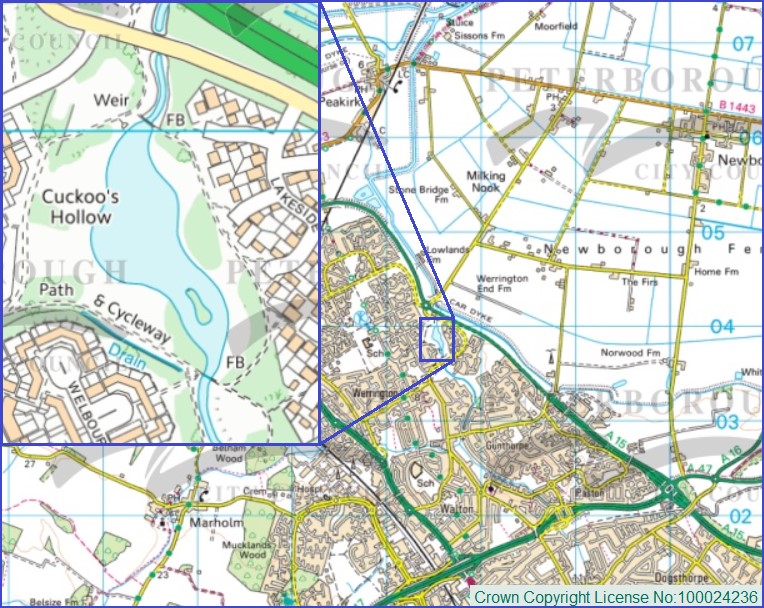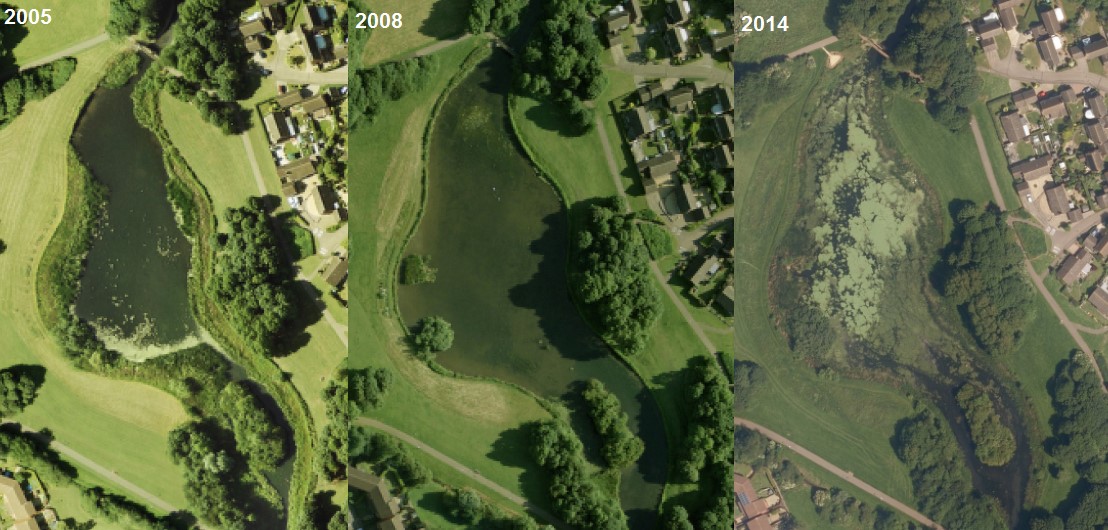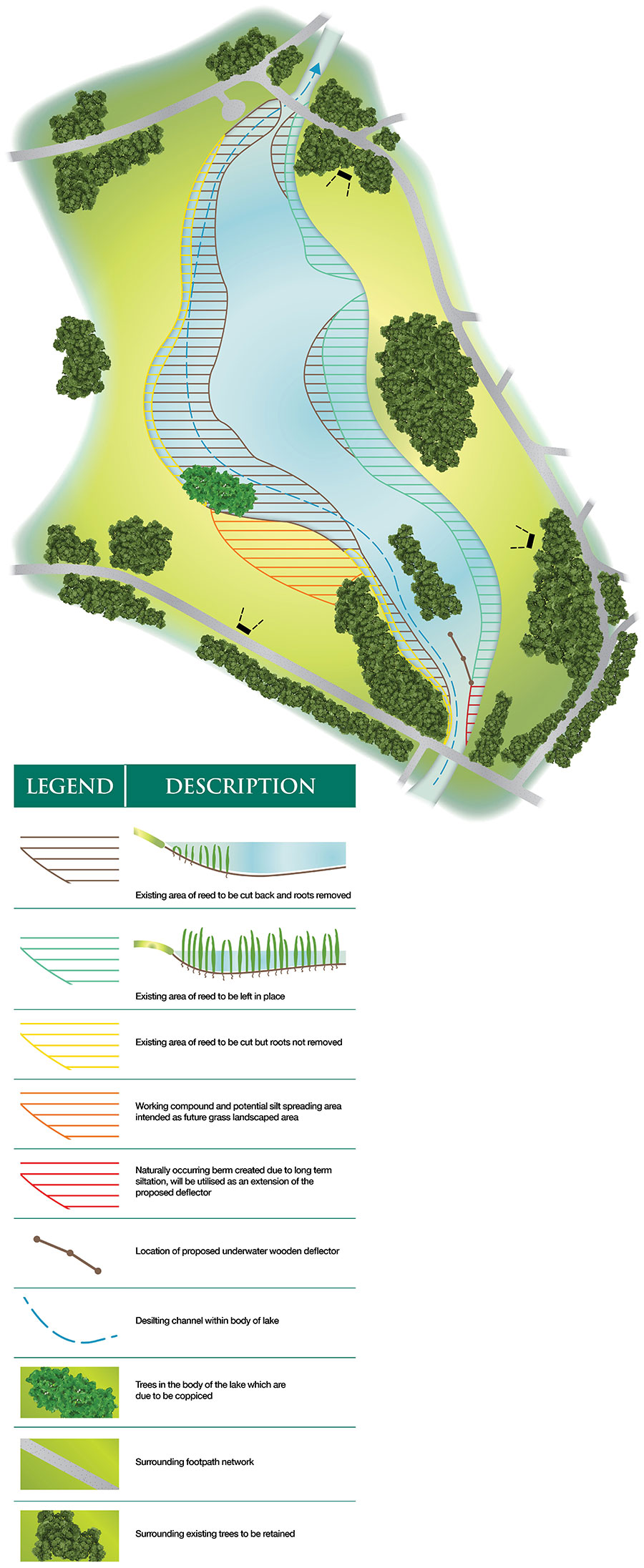Location and background
Cuckoo’s Hollow was created by Peterborough Development Corporation in the 1970s.
It is an important part of the character for Werrington, providing valuable amenity, wildlife and flood risk benefits.
Over recent years the reed growth has extended more and more into the body of the lake and silt levels within the lake have built up. If left to natural processes the reed will eventually cover the lake and views of open water will be limited.

Striking the right balance
There are a number of constraints, opportunities and varying opinions on how the lake should look, its purpose and therefore how it should be maintained, some of these are set out below and reflect the concerns of residents and partner organisations.
A compromised maintenance approach has been proposed to regenerate this feature with a long term vision and within the limited budgets, this looks to provide multiple benefits and hopefully allow the space to be enjoyed by local residents and wildlife whilst preparing for future WBI works.
| Opportunity | Action |
|---|---|
| Werrington Brook Improvement (WBI) | |
| In the long term the WBI will improve the quality of water entering the lake and reduce the silt loading.
The WBI options for Cuckoo’s Hollow Lake have also been discussed and presented for wider consultation. |
Baseline bathymetric and habitat surveys from the WBI Feasibility Report have been used in preparing these proposals
Whilst future silt loading will be reduced by WBI actions there are still volumes of silt within the lake which have built up over time. The maintenance will aim to remove some of this silt and improve flows through the lake. The works carried out as a part of the maintenance look to clear the reed from the western bank and direct flows towards that bank in preparation for the WBI proposals for this location The installation of a flow deflector at the southern end of the island |
| Conflicting visions for the lake | |
| It has been highlighted through the WBI consultation that different users of Cuckoo’s Hollow have different ideas of what the lake should be. These opinions are wide and varied but predominantly fall in these two categories;
• Preference for a more natural feature which would see reed growth across the lake and development of a more extensive habitat |
Whilst leaving the lake to evolve naturally has the potential to reduce the existing flood risk benefits, it is possible to sustain habitat within Cuckoo’s Hollow without increasing flood risk. Existing budgets are not sufficient to allow a complete reed and silt removal.
These works are proposing a compromise between the two ends of this scale with the lake given designated areas for use of the open space, views of clear water and a healthy habitat area; • reed growth cut back around the western side of the lake to ensure a view of open water from the low laying open space from the west • reed growth to the east of the site will predominantly be left in situ to provide a substantial wildlife margin • the height of the footpath to the east of the lake also means that a view of open water should be seen above the reed growth from this side • some small self-set trees will be removed from the bank where they have the potential to damage the bank support but all established trees in the open space areas will be left in situ. |
| Managing wildlife | |
| The lake and its surroundings are a thriving habitat and this needs to be, not only, protected but also better understood and monitored. | • The original approach to reed cutting has been revised to ensure a reasonable habitat is left on site for the reed warblers that have previously been spotted with future monitoring of wildlife to be investigated through the WBI
• A margin of reed roots will be left along the western embankment until a habitat survey for water voles can be completed next year, the presence of wooden bank supports around the lake puts doubts on the ability for this area to provide an adequate habitat but this will be confirmed |
| Amount of desilting | |
| There have been suggestions that the whole lake would potentially benefit from dredging/ desilting. | There is insufficient resource to desilt the whole body of the lake as such the focus for silt removal is to keep a clear high energy channel within the body of the lake which will help to sustain flows and tie in with future planned improvements |
| Oxygen levels and algal blooms | |
| The activity of reed removal and desilting agitates the sediment and has the potential to result in algal blooms and reductions in oxygen levels. There is concern that this work may therefore harm wildlife present in the lake.
Aerial images show that algal blooms have been experienced at Cuckoo’s Hollow as recently as 2014 even when no maintenance was taking place |
As a part of the works the following mitigation measures are to be applied:
• Oxygen levels in the water will be constantly monitored • A silt pushing boat will be used to move the sediment which reduces the amount of silt being animated within the lake compared to a long arm tracked vehicle • The reeds will also be cut with an amphibious vehicle which also helps to contain the disruption |
| Waste Management | |
| Historically the deposition of reeds and silt along the bank and how this land has then been managed has caused concern due to the appearance, smell and lack of longer term management of those open space areas.The quality of this sediment and its disposal on the water’s edge has also been a concern. | The cost associated with the removal of all waste from the site would be both prohibitive and unsustainable, to ensure previous mistakes are not repeated the follow steps are due to be undertaken;• Reeds will be deposited along the bank for two to three weeks to allow the water to drain down, at this point they will be removed from the site for composting
• A net will be spread across the watercourse at the outfall for the lake to prevent debris floating downstream • the silt will be spread over the compound area and allowed to naturally drain down before being harrowed and seeded with grass seed, we believe it is critical to the project that the follow up landscaping and seeding of the silt takes place to ensure that the current scrub land area is improved to allow grass to establish • Tests have been carried out on the quality of the sediment to confirm that it is not highly contaminated but a precautionary 1-2m wide grass filter strip will be left between any silt drying on the bank and the lake to help prevent the migration of sediment and nutrients from the silt into the lake |
| Capacity within the lake | |
| There are concerns that capacity for flood water attenuation has been lost in the lake through long term siltation | • The use of the deflector and desilting of an underwater channel is being piloted to help sustain an efficient flow route through the lake and prevent further siltation
• The proposed works will not reduce the water storage capabilities of the lake and aim to remove approximately 800m3 of silt from the lake • Silt present under the surface of the water will not reduce the water storage capabilities of the lake as long as a consistent flow can be sustained for the main river running through the lake |
| Costs | |
| As has been previously highlighted the resources available to complete the proposed works is extremely limited | Negotiations with the various interested parties have allowed a number of cost savings to get this project delivered including;
• Management of waste onsite where possible • Reducing reed cutting to sustain habitat • Minimising volume of silt removal • Use of technology new to the industry |
Maintenance Proposals
| • | Undertake landscape and scrub management around the Western side of the lake |
| • | Access open space to set up Works compound |
| • | Cut back reed growth and remove reed roots using amphibious vehicle, these reeds are to be left on the bank to drain down naturally |
| • | Once drained the reeds and their roots will be removed from site for recycling, this may be 2-3 weeks after the cutting takes place |
| • | A silt pushing boat will then create a channel from south to north along the western side of the lake, the silt will be removed from the lake from the compound site meaning the remainder of the open space should not need accessing by heavy vehicles |
| • | The deflector will be installed below the water level at the inflow to the lake |
| • | Silt to be stored on the bank in the compound to allow water to drain back into the lake. During this process a grass margin will be left to ensure water is filtered as it travels back to the lake. |
| • | Once the water has drained down from the silt it will have lost approximately 75% in volume, this may take a few weeks to be fully drained. At this point the silt can be landscaped, harrowed and seeded with grass seed |
| • | Ongoing monitoring of open space and wildlife |
Aerial views of the lake

Maintenance Map

Further Information
Details of the Werrington Brook Improvement Programme
www.pect.org.uk/werringtonbrook
Welland Rivers Trust
http://www.wellandriverstrust.org.uk/index.php/werrington-brook-improvements/















